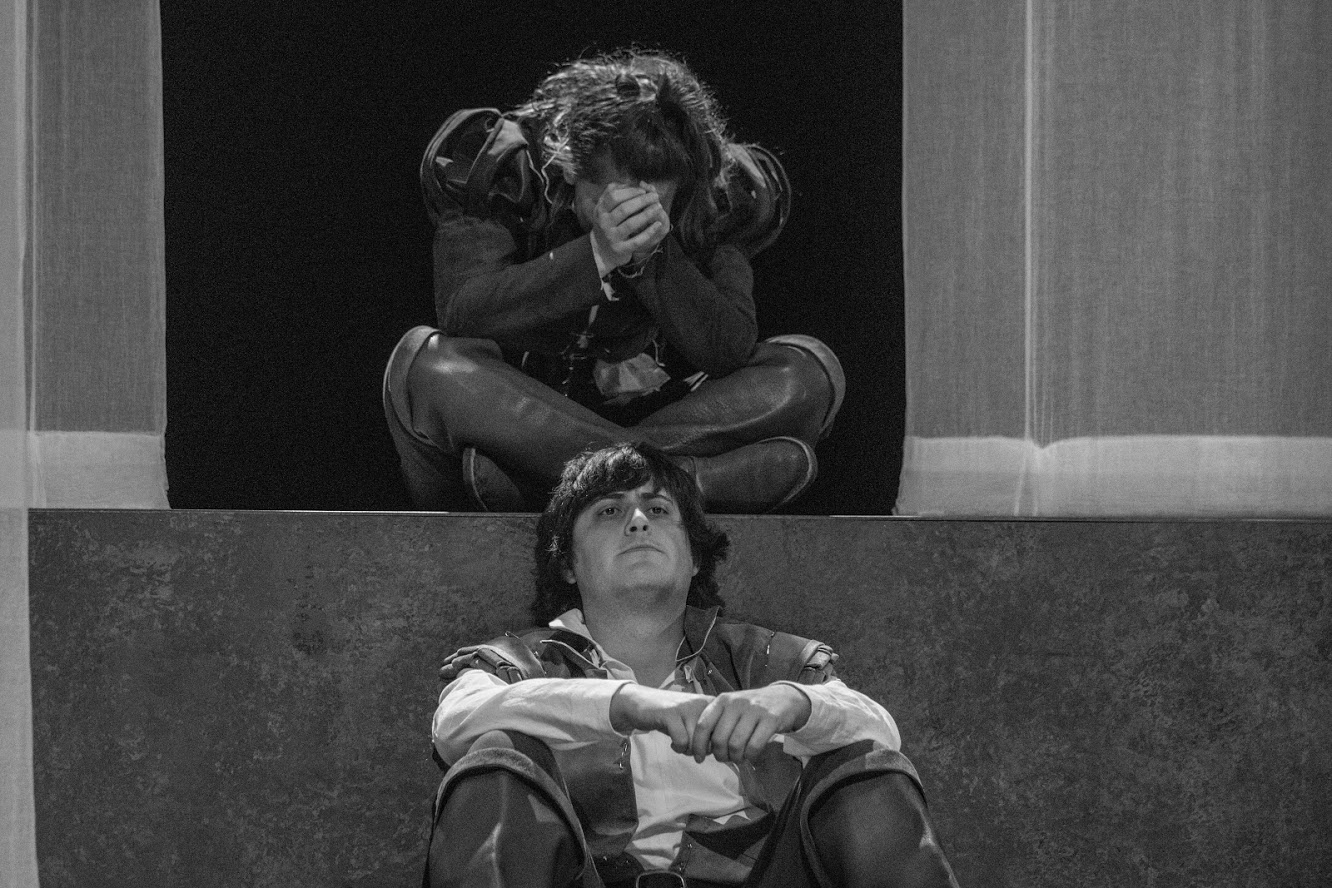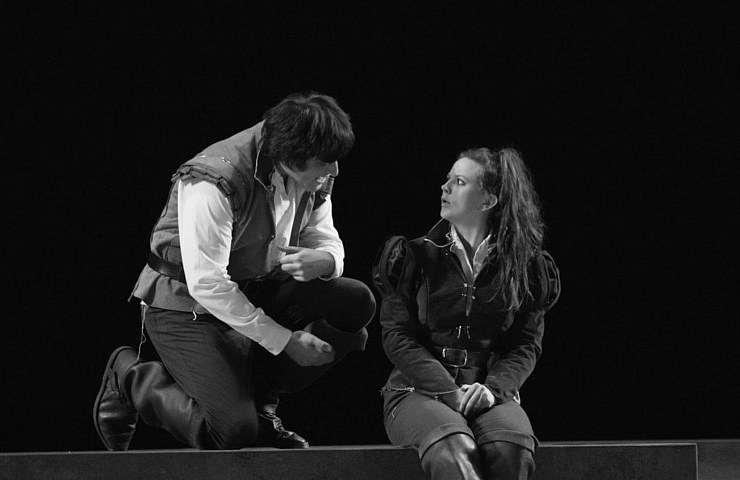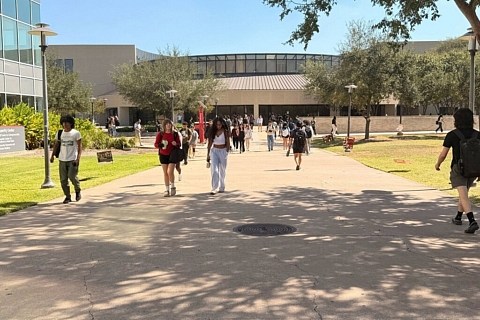It’s the opening night of UH’s newest theatre production. The curtain rises to reveal a beautiful set, and perfectly placed spotlights illuminate the characters in their costumes that seem to come from another world. As the story progresses, the spectators probably don’t stop to think about the hours upon hours of rehearsal and the hearts of more than just the people on stage that went into this show to make it possible.
“Rosencrantz and Guildenstern Are Dead” took over 40 minds to create – including actors, directors, stage managers, set and costume designers and even a dramaturg.
Adam Noble, the associate professor and director of the play, said their goal is to make each semester a diverse season of plays with multiple genres. This production was one of five that were pitched by the director for the season and has been tossed around for years.
For Noble, a movement specialist, this play has a special place in his heart. Fifteen years ago, he was cast as The Player in “Rosencrantz and Guildenstern Are Dead.” His director at the time suggested he participate in dumb shows – shows without speech – to prepare for his role. Working with dumb shows to improve his role ended up becoming transformative for him, and Noble believes it could be a good reason why he specializes in movement now.
“Adam is like a movement person to the nth degree,” said Thaddeus Walker, a graduate student in the UH Theatre Department and the actor bringing Rosencrantz to life this semester. “He understands physicality better than anyone I’ve ever met, and how the slightest move can say the biggest thing. It’s so interesting and so useful for the show that we’re doing to have a movement person direct a language play. I think it’s going to make this a different version of the play than most people are used to.”
For Noble and his theatre teammates, it’s a long journey from the first look at the script to the moment the lights come up on opening night.
For spring semester performances such as this one, the process begins about three-fourths into the preceding fall semester with auditions.

Photo by Thom Dwyer
“You’re basically showing up with a monologue and a song, and all the directors are in the room, and all the faculty are in the room,” Walker said. “Then from there they’ll do callbacks, and we’ll just go into a room and do readings from the play. Usually about a week after the fall auditions for the spring shows we’ll find out what show we’re going to be in for the spring.”
Each show of the semester has their own individual callbacks for actors that the directors would like to use in the play, and usually an actor will be called back to read a specific character. In Walker’s case, he was called back for the part of Rosencrantz and only read for this role. Other times actors will be asked to read several different characters during callbacks.
“This play is interesting,” Walker said after being asked how the first few rehearsals work after the cast is established. “We found out at the end of October that we were going to be doing it, and we knew we didn’t start until after Valentine’s Day. Madison (Guildenstern) and I also knew that we had a ridiculous amount of lines to learn, so we started learning our lines before we even came back from Christmas break.”
The first read-through, where the cast gets together to read through the script as their characters for the first time, took place in mid-February. The rest of that week consisted of slowly going through the play “trying to find jokes,” Walker said.
Rehearsals for the following two weeks involved figuring out the exits and entrances of characters, establishing movement and playing through the script to find out what they needed to create a believable world.
After having the next week off for Spring Break, the cast only had two more weeks before a weekend of tech rehearsals. During this time, different parts of the production such as lights and costumes came into play.

Photo by Thom Dwyer
In total, the play had five weeks of regular rehearsals, then half a week for a dress rehearsal and a preview before opening night on Friday, April 6.
While actors like Walker are the ones taking center stage when the curtain rises, many students are working backstage to bring the production to life.
“The designs for costumes in (Rosencrantz and Guildenstern) was the fruit of a lot of collaboration with our design team, including Scenic, Lighting, Sound, etc. and of course the Director,” said Victoria Nicolette Gist, a graduate student studying costume design and one of the designers for this production. “In the costume shop, we had, all in all, around 30 people working on build and alterations in various capacities. However as far as the costume design itself – the renderings, the research, the fabric – that’s all me.”
While some props and costumes were recycled from other performances, many parts of the play were built by the crew. This includes Rosencrantz, Hamlet and Guildenstern’s doublets, the Player’s outfit, Gertrude’s outfit and Claudius’ sir coat, said Gist.
“First impressions really are everything, and so often our first impression of a character onstage is based off of how they appear, not what they say,” Gist said. “I like to think that if the eyes are the window to the soul, then one’s clothing is a billboard.”

Photo by Thom Dwyer
Costumes and props aren’t the only things to be designed and created. The setting was painted by hand, and there was even someone who came up with the plot for the lighting, according to Director Noble.
Of course, there would be no production if it weren’t for the stage managers and the dramaturg to keep everything in line.
“The dramaturg essentially is the mediator between the artistic visions of the director and the playwright,” said Roby Johnson, a first year M.A. candidate in theatrical studies and dramaturg for Rosencrantz and Guildenstern. “While a script should be followed closely, the dramaturg assists in making sure that the translation of a play on the page to a play on the stage accurately represents the ideas of the playwright.”
The dramaturg can also be in charge of making research packets for the cast and crew so they can make “informed artistic decisions,” Johnson said, showing it takes even more than actors, designers, managers and techs to put on a great show.
When attending a rehearsal, it is easy to see the strong relationships the cast and crew form. Before the scheduled rehearsal time, some of the cast can be seen outside the theatre, broken up into groups going over scenes together and laughing when they can break character. There is not a quiet or still person in the room.

Photo by Thom Dwyer
Entering the theatre when it’s time to officially start, the director might be nowhere to be seen before suddenly peeking out of a wooden prop box on stage. Throughout the evening this laughter and joking continues between cast, crew and directors alike, showing how comfortable this family is with each other and in the theatre.
Most of the rehearsal time is spent going over scenes repeatedly until the directors and actors are satisfied enough with it to move on to another scene. Based on the directors’ notes or their own intuitions, the actors will try the scene differently each time until they “feel it.” Then when they find what they like, they will probably go over the scene again, “just to hammer it in,” as Noble would say.
“It’s astounding to be part of such a rigorous and professional theatrical program that has so many talented people,” Johnson said. “The culture is magical and I’ve been challenged to grow in so many incredible ways.”
When you go see UH’s production of “Rosencrantz and Guildenstern Are Dead” on April 12, 13 and 14 at 8 p.m. or April 15 at 2 p.m. at the Lyndall Finley Wortham Theatre, chances are you will be so taken in by the brilliant beauty of the set and the convincing performances of the talented actors that you won’t think of much else.
During intermission or after the cast finishes their curtain call, however, you might stop and take a moment to appreciate just how much blood, sweat and tears – both real and fake – it took from the cast and crew to create this whole new world that plays itself out on stage.




Recent Comments